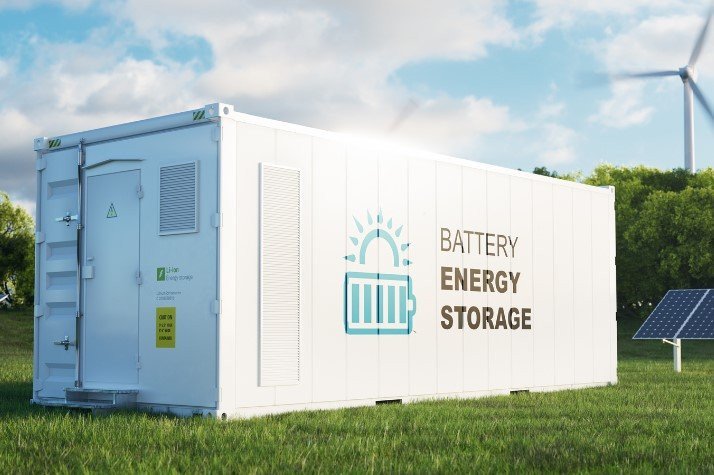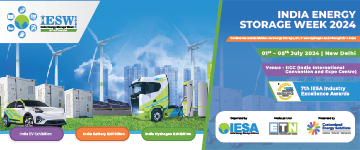Will PLI be the ace in the ‘Make in India’ sleeve?
New avenues of growth in the RE sector and a blossoming EV market have led to a promising rise of the storage sector. Add to this, the government's efforts in promoting local manufacturing of battery cells and auto components through suitable policies and subsidies like the recently approved PLI scheme for ACC battery storage, and we might be on the horizon of a new dawn.
India has the potential to be a thriving market for e-mobility. EV sales in India notched close to 3,80,000 in 2019-20. IESA estimates that the EV market is expected to grow at CAGR of 44 percent between 2020-27 and is expected to touch an annual sale of 6.34 million units by 2027. The rise in oil prices, environmental concerns, and introduction of newer EV models by OEMs, are all indicative of a growth in demand for EVs. Needless to say, demand for energy storage solutions will be inevitable with growth in EV manufacturing.
Niti Aayog states that India will need 50 GWh of battery storage capacity over the next 2.5 years to support the projected growth in RE, and to meet the national e-mobility targets. IESA evaluates the annual battery demand to grow at 32 percent to reach 50GWh by 2027, and the battery market is expected to grow to $14.9 billion by 2027.
Prospects for the battery market
India has a long way to go, many industry insiders believe. The battery market here needs to mature yet to achieve the perceived level of manufacturing capacity. For one, we largely depend on the import of cells as local manufacturing has still to catch on. On the positive side, a lot of change is expected in the next five years that could turn the current scenario.
In a much-awaited announcement in early May, the Cabinet headed by the prime minister approved the proposal of the Department of Heavy Industries (DHI) for implementation of the production-linked incentive (PLI) scheme 'National Programme on Advanced Chemistry Cell (ACC) Battery Storage'. According to the statement released by the PIB, the objective of this program is to achieve a manufacturing capacity of 50GWh of ACC and 5GWh of 'niche' ACC, with an outlay of ₹18,000 crore.
This move follows the launch of the National Mission for Transformative Mobility and Battery Storage (NMTM&BS) that aims to enable faster adoption of e-mobility and battery storage and the establishment of a strong domestic supply chain to support. Widely welcomed by the industry leaders, the PLI-scheme is considered a concrete step towards achieving aatmanirbharta (self-reliance) in manufacturing.
Speaking to media, CEO of Niti Aayog, Amitabh Kant stated that ACC battery manufacturing represents one of the largest economic opportunities of the twenty-first century for several global growth sectors, like consumer electronics, EVs, and RE. The PLI scheme for ACC battery will incentivize large domestic and international players in establishing a competitive ACC battery set-up in the country, he said.
The PLI objective
The aim of the PLI scheme is to provide incentives to companies on incremental sales from products manufactured in domestic units. Even foreign companies can set up units in India through this scheme. However, the main intention is to encourage local companies to set up or expand existing manufacturing units.
As stated in the PIB release: 'ACC battery storage manufacturers will be selected through a transparent competitive bidding process. The manufacturing facility would have to be commissioned within a period of two years. The incentive will be disbursed thereafter over a period of five years.
The incentive amount will increase with increased specific energy density and cycles, and increased local value addition. Each selected manufacturer would have to commit to set-up an ACC manufacturing facility of minimum 5GWh capacity and ensure a minimum 60 percent domestic value addition at the project level within five years.
The beneficiary firms will have to achieve a domestic value addition of at least 25 percent and incur the mandatory investment ₹225 crore /GWh within 2 Years (at the mother unit level) and raise it to 60 percent domestic value addition within 5 Years, either at mother unit - in-case of an integrated unit, or at the project level, in-case of 'hub & spoke' structure.'
The effect of the pandemic on global supply chains has been devastating for many companies and projects. It has brought to light the country's dependence on imports, especially from neighboring China. Through the COVID-ravaged economic conditions, the importance of self-reliance has become more pronounced.
Even globally, manufacturers are looking at alternatives to delink their dependence on China. Maybe it is an opportunity for India to step up as an export hub. Here's also where the PLIs could encourage manufacturers to increase production of home-grown products, enabling substitution of imported products or parts. The focus of the government, in driving battery production, shall be on economies of scale and enhanced performance output; remaining neutral in terms of type of technology.
The cost perspective
As per a global study conducted to gauge the impact of battery costs on EV adoption, a decrease in battery prices is expected by 2025. This will definitely bring the purchase cost of EVs down, resulting in an encouraging rise in demand for EVs. This is evident in the fact that there already has been a decrease in the cost of Li-ion batteries by over 50 percent until 2014, globally.
In India too, battery prices have seen a significant fall. In 2010, it was about $1000 per kWh, which fell to about $200 per kWh by 2018. If the prices continue to come down, e-mobility and battery storage will be the knocking opportunity for manufacturers and investors in the country.
Research reports deduce that India will need a minimum 10 GWh of cells by 2022 and 50 GWh by 2025. Whether this expectation means there will be a rise in demand for EVs in the coming years is what the industry is eagerly waiting to see.
Industry welcomes move
The Industry response to the ACC PLI scheme is very encouraging, though not very forthcoming. Manufacturers of EVs, charging infra companies, and RE ventures, all have expressed a positive outcome of the scheme. The general response is that the government mandates might be the missing link between EVs and mass adoption. In that aspect, the subsidies announced through PLI could well give a boost to local manufacturing and intensify domestic demand for commercial consumption of EVs across India.
This approach can go a long way in creating a robust ecosystem for EVs and could also raise India's position as a global EV hub. Setting up a competitive ACC battery manufacturing environment will create opportunities for new jobs, attract investments, interest international players, and make way for further innovation. Early investments in this sector could enable a sturdy supply chain and vendor base. Most battery manufacturers are keeping a close excited watch on further development in this sector and are prepared to step in when the time is right.
ACC refers to the new generation advanced storage technologies that can store energy either as electrochemical or as chemical energy and convert it back to electric energy as and when required. Many manufacturers have started showing interest in exploring newer battery technology, other than Li-ion, to avail the benefits of the subsidies offered under the scheme.
Speaking at the virtual conference - 'Roadmap 2021: Driving towards cleantech and e-mobility' - organized by IESA early this year, Dr. Rahul Walawalkar, President – IESA, said: "I look at 2021 as the year of adoption of new technologies and government framework. This is a great opportunity for developing the local supply value chain. We need to start focusing on the adoption on an accelerated scale," adding that the scale at which projects are happening in India needs to be revamped and fast-tracked, to make it attractive for financial institutions to start funding stationary storage and e-mobility ventures in India.
Will Li-ion roar?
So far, Li-ion battery technology has been the most favored in the global EV market. In India, though, lead-acid dominates the market, while Li-ion is still in its infancy. The main reason being the lack of demand and availability of raw materials to make Li-ion cells.
According to experts, the demand for Li-ion batteries is not yet adequate to be manufactured in India; the minimum capacity required to make EVs competitive is still wanting. Then there are other hurdles that need attention, like raw material procurement. For cells to be made in India, the cost of importing raw materials like lithium and cobalt (essential to make Li-ion cells) would be significant.
Many companies have begun to explore other battery chemistries, with lithium iron phosphate (LiFePo) and lithium manganese cobalt oxide (NMC) chemistries being the most common.
Raw material security for cell manufacturing is a matter of concern. The government needs to explore the possibility of lithium reserves in India, which could give battery manufacturing a big boost. Recently, over 14K tons of lithium reserves were found near Bengaluru by the researchers of the Atomic Minerals Directorate, a unit of India's Atomic Energy Commission at Mandya. Acquiring raw materials through discoveries in India or assets abroad is of importance.
Raw material linkages and policy announcements that focus on building and growing the entire vertical supply chain are the main factors that will pave the way for the industry. As aptly pointed out by an industry leader – 'Without these, our industry readiness will be not for Make in India but Assemble in India.'
However, the focus should be on not just setting up a thriving supply chain, but also on creating demand to stimulate production. India has waited too long on the sidelines, it's time to jump in the race and make the most of it.
Companies in the fray
Apart from leading Indian companies and conglomerates, many global companies are also keen on entering the Indian market. Global Companies like Tesla, Triton, EOSE, BYD, and ATL have already taken steps to establish their setup in India. Indian PSUs like the Indian Oil, BHEL, NTPC, HPCL, and Oil India are also looking to diversify into this new sunrise sector. Leading battery manufacturers like EXIDE, Amara Raja, LivGuard, Okaya, and others are seeing this as an opportunity to explore advanced technologies and evaluate global technology partnerships to get into newer technologies.
According to Debi Prasad Dash, Executive Director, IESA, "US electric giant Tesla's recent foray will lead the Indian EV market to see quality products and healthy competition among global and Indian players. On the other hand, innovative solutions in EV infrastructure and business models like battery swapping, Battery-as-a-Service (BaaS), Vehicle-to-Grid (V2G), and applications like electric boats and electric aerial transportation, will open the market for new emerging start-ups. More than 100+ start-ups have entered this space and received funding from global investors and leading conglomerates."
The production-based incentives under the scheme are based on the incremental sales of the company starting from 2022. But setting up a mega-sized factory for the basic production requirement to qualify for the incentives, in itself is a tough task that will require at least two years to set up and get going. This might be a seeming deterrent, as the manufacturers can only start benefitting from the scheme after a few years.
The approval of the scheme is a welcome move, but the smooth implementation of the scheme is what will determine its success. The e-mobility scene is showing signs of warming up, but for the market to mature and for demand to justify production capacity, will take time.
Based on media reports, following are some recent happenings in battery manufacturing.
The States in India too need to come up with strong industrial policies and supporting incentives in terms of land, power, and labour to encourage the setting up of factories. Following is the progress being made in some States that could lay the foundation for a 'Make in India' reality.


























